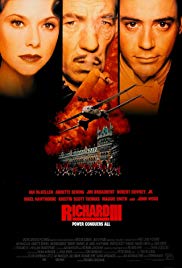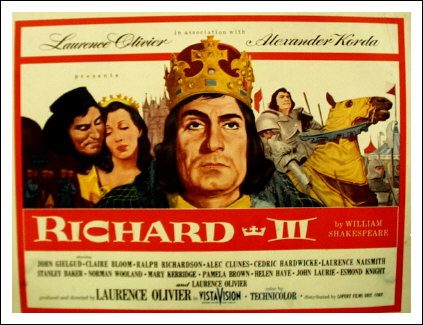RICHARD III
SUBJECTS — Drama/England; World/England;
SOCIAL-EMOTIONAL LEARNING — Brothers; Ambition;
MORAL-ETHICAL EMPHASIS — General.
AGE: 12+; No MPAA Rating;
Drama; 161 minutes; Color. Available from Amazon.com.
There is NO AI content on this website. All content on TeachWithMovies.org has been written by human beings.

SUBJECTS — Drama/England; World/England;
SOCIAL-EMOTIONAL LEARNING — Brothers; Ambition;
MORAL-ETHICAL EMPHASIS — General.
AGE: 12+; No MPAA Rating;
Drama; 161 minutes; Color. Available from Amazon.com.
TWM offers the following worksheets to keep students’ minds on the movie and direct them to the lessons that can be learned from the film.
Film Study Worksheet for ELA Classes;
Film Study Worksheet for Social Studies Classes for a Work of Historical Fiction and
Worksheet for Cinematic and Theatrical Elements and Their Effects.
Teachers can modify the movie worksheets to fit the needs of each class. See also TWM’s Historical Fiction in Film Cross-Curricular Homework Project.
This is the classic Lawrence Olivier version of Shakespeare’s play “Richard III.”
To understand this film better, children (and adults) should first see Looking for Richard in which Al Pacino gives an entertaining introduction to the play and its historical and dramatic background.

Selected Awards:
1957 Golden Globe Awards: Best English Language Foreign Film; 1957 Academy Awards Nominations: Best Actor (Olivier).
Featured Actors:
Sir Lawrence Olivier, John Gielgud, Claire Bloom, Pamela Brown, Alec Clunes, Cedric Hardwicke.
Director:
Sir Lawrence Olivier.
“Richard III” is a study in ambition run amok. It is a classic drama and contains beautiful poetry. The film is also an excellent introduction to Shakespeare’s histories. With the corrections and supplementation contained in the Learning Guide to “Looking for Richard“, the movie can be a valuable adjunct to the study of the Wars of the Roses, a pivotal time in English History.
None.
Before watching this movie with your children, watch Looking For Richard.
For the remainder of this Learning Guide, see Learning Guide to “Looking for Richard“.
Olivier, following a long tradition, has modified the play by adding a scene and moving a few scenes around in an effort to make the meaning clearer to a modern audience.
This Learning Guide was last updated on December 17, 2009.